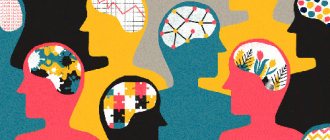Oligophrenia is a syndrome of congenital mental defect. This disease is expressed in the form of mental retardation, formed due to pathologies of the brain. The main manifestations of this syndrome are in the form of disturbances in the thought process, will, speech, motor skills and emotions. This disease is characterized by defective mental development in a fully formed adult.
Mental retardation oligophrenia
This deviation causes mental retardation, which is expressed in:
- a decrease in skills acquired as a person grows up;
- delays in the general development of intelligence.
In fact, in medicine there is a general term that refers to all deviations in human development - mental retardation. Oligophrenia can be distinguished from other pathologies by the following characteristics:
- very difficult to train;
- repeated mastery of the same task practically does not increase the chances of mastering it;
- complete destruction of brain functions;
- intellectual dysontogenesis;
- with very rare exceptions, the inability to become a full-fledged member of society.
Diagnosis of oligophrenia
At the current stage of development of medicine, some of the diseases that are associated with mental retardation can be detected even at an early stage of pregnancy. One such disease is Down syndrome. If it is detected, the doctor must tell the parents in detail about oligophrenia and how this pathology may be accompanied. They should know how a child who develops this disorder can grow up. This is necessary so that parents can decide for themselves whether they should terminate the pregnancy or not.
Another stage of the diagnostic study begins immediately after the birth of the baby and consists of a blood test for the presence of hypotherosis and phenylketonuria. These diseases often cause mental retardation.
When symptoms of oligophrenia appear in a child who was considered completely healthy until that time, a fairly wide range of studies are carried out to search for its causes. To begin with, the history of his life and the presence of various diseases, mainly mental, along the family line are examined. The pregnancy history is also checked for asphyxia or hypoxia. The postpartum period is also important in this case, especially regarding possible injuries to the child at this time.
After all this, the child is examined to identify neurological and mental abnormalities, as well as to determine the severity of the disease if it is detected. This is followed by other studies that are designed to determine diseases of the internal organs, dysfunction of the enzyme system and the presence of congenital diseases. Depending on the results obtained, subsequent actions are determined.
Diagnostics
To accurately establish the presence of oligophrenia, it is necessary to conduct special tests (psychological). The doctor will evaluate the child’s mental and speech development, vocabulary, note how others perceive him, and the presence of abstract thinking. It is important that this technique is suitable only for children starting from 3 years old. If the disease is suspected in a younger child, the following research methods are used:
- MRI of the brain;
- karyotype study;
- genetic tests;
- assessment of the baby's memory;
- blood screening for phenylketonuria and hypothyroidism;
- encephalography;
- congenital infection samples;
- comprehensive examination.
Causes of mental retardation
All causes of this syndrome are usually divided into two types: congenital and acquired. The first include:
- prematurity of the child;
- genetic abnormalities;
- chemical or infectious damage to the fetus;
- exposure to ionizing radiation while inside the womb;
- birth injury;
- asphyxia.
Acquired causes of the development of oligophrenia include:
- central nervous system infections;
- head injuries;
- hypoxia of the brain.
Often mental retardation is caused by pedagogical neglect, characteristic of dysfunctional families. In addition, there have been cases of oligophrenia, the causes of which have not been fully elucidated.
Approximately 50% of cases of this disease are the result of genetic changes. These are mainly chromosomal abnormalities, which include Down syndrome and other similar manifestations. Sometimes mental retardation is caused by a dysfunction of certain genes or their mutation, the degree of which exceeds a thousand. In addition, oligophrenia can accompany diseases such as:
- Toxoplasmosis. Caused by parasites that accompany domestic animals. When ingested by a pregnant woman, they also penetrate into the fetus, causing many malformations.
- Phenylketonuria. Caused by a disorder of phenylalanine metabolism. As a result, a large number of toxic products of its breakdown are formed. If you start treatment in a timely manner, you can avoid the formation of oligophrenia.
- Microcephaly. It represents the formation of a skull that is too small relative to the size of the brain. Accordingly, the brain also slows down its growth.
- Hydrocephalus. It consists of the accumulation of too much fluid in the brain area due to obstructed outflow or too rapid formation.
Treatment
Photo: narkolog-psihiatr.ru
Drug treatment in adult patients does not improve intelligence. But the identification and prevention of oligophrenia in infancy play an important role. Early detection of infections (syphilis, listeriosis, toxoplasmosis) allows treatment to begin in the absence of organic brain lesions. If enzymopathies (enzyme deficiency) are detected, special diets are prescribed (for phenylketonuria, foods containing phenylalanine are excluded), which helps prevent the development of intellectual disorders. When oligophrenia is detected early, medications are prescribed that can mitigate the effects of the disorder (more on this in the “Medications” section).
An important aspect in the treatment of oligophrenics with mild intellectual impairment is social therapy. Such patients are capable of imitation. It is necessary to employ oligophrenics in institutions where they will be constantly monitored by a mentor, otherwise, due to their tendency to become distracted, the patient quickly stops working.
Features of oligophrenia
This phenomenon belongs to a wide group of diseases that are associated with developmental disorders. It is considered to be an abnormal underdevelopment of a person’s mental state, his personality and even the whole organism. Every hundredth person in industrialized countries suffers from this disease. Moreover, more than 3/4 of this number have mild mental retardation. There are twice as many men with oligophrenia as women.
It is not possible to conduct more accurate statistical studies because there are differences in the diagnosis of this disease, in the degree of society's tolerance for mental disorders, and in the availability of medical care.
Oligophrenia is not a progressive disease. This is most likely a consequence of a previous serious illness. The degree of mental retardation of patients with this disease is assessed by a special coefficient, which is derived on the basis of psychological tests. It is extremely rare for oligophrenics to be recognized as incapable of adapting to life in society.
Sources
- Manual of Psychiatry. In 2 volumes. T.1/A. S. Tiganov, R 84 A. V. Snezhnevsky, D. D. Orlovskaya and others; Ed. A. S. Tiganova. - M.: Medicine, 1999. - 712 p.: ill., [2] l. ISBN 5-225-02676-1
- N. N. Ivanets, Yu. G. Tkshyshn, V.V. Chirko, M. A. Kinkulishna: Psychiatry and Narcology. - M.: GEOTAR-Media, 2006.-832 p.
- V. P. Samokhvalov: Psychiatry. – textbook for medical universities: 2002 - 324 p.
- Fundamentals of psychiatry: visual materials for a course of lectures for 0-75 students studying in the specialty 1-23 01 04 “Psychology” / comp. A. I. Gorbachev. – Minsk: BSU, 2014. – 73 p.
Oligophrenia symptoms and signs
In fact, it is not entirely correct to call oligophrenia a disease, because it is actually a pathological condition caused by various kinds of diseases. Symptoms of oligophrenia appear in combination with somatic manifestations, as well as disturbances in the emotional, motor and speech spheres. Some of the most common manifestations of this condition are:
- Delay in physical development. Depending on the form of this disease, it can be almost invisible or very severe. For example, an adult may look like a teenager of 15-16 years old.
- Slowing down of personal development. Most often it manifests itself in everyday situations, such as choosing clothes or buying groceries. Such oligophrenics are easily suggestible, unable to make adequate decisions on their own.
- Weakened memory. Most often, such a person remembers numbers, names or numbers very selectively. And he does it completely mechanically.
- Distracted attention. A person simply cannot concentrate on one thing. They are constantly distracted.
- Poor vocabulary and illiterate speech. With a mild form of the disease, a person can even be taught meaningful reading. If a person is diagnosed with a severe form, then the maximum that can be achieved even after many years of training is mechanical spelling. In this case, the mental retard will not even understand the meaning of what he just read.
- Comprehensive mental retardation. The difference from ordinary mental retardation is that it affects not only personality characteristics and intelligence, but also all other traits of human character. These include the ability to perceive, emotions, speech, memory, motor abilities, willpower, the ability to think and concentrate.
- Abstract thinking disorder. This symptom can be called the most characteristic. A person suffering from oligophrenia completely lacks imaginative thinking. It is more based on a specific situation, which is typical for two or three year olds.
The most vivid and detailed symptoms appear only at school age. In children under one year of age, mental retardation is almost impossible to determine, except perhaps in the most severe cases. As for younger children, such deviations can be identified by a lag in speech and mental development, as well as a lack of interest in the world around them.
Folk remedies
Photo: venskayadacha.com
Traditional medicine is not able to restore the patient's intelligence
However, it is possible to pacify a person suffering from intellectual disorders during outbursts of violence and aggression. The following herbal collection is suggested: prepare one tablespoon each of fragrant rue and valerian roots, pour boiling water over this collection, let it brew for 30 minutes. Give the person to drink throughout the day, strain before drinking.
For insomnia, take a bath with herbs such as calendula, mint, oregano. Also, to improve sleep, they resort to decoctions of valerian root (2 tablespoons of valerian root are poured into 1.5 cups of boiling water, heated for 15 minutes in a water bath. Take 3 tablespoons after meals before bedtime).
The information is for reference only and is not a guide to action. Do not self-medicate. At the first symptoms of the disease, consult a doctor.
Forms of oligophrenia
In total, there are three forms of oligophrenia:
- First. Caused by hereditary factors. These include diseases such as Crouzon syndrome, Marfan syndrome, true microcephaly and others.
- Second. It is characterized by the fact that the development of oligophrenia is caused by damage to the fetus inside the womb. This is usually caused by various viral infections, toxoplasmosis, congenital syphilis, hormonal disorders or listeriosis.
- Third. Usually occurs during fetal development when exposed to factors such as Rh factor conflict. The afterbirth period is affected by birth trauma or asphyxia. And the transmission of infections, traumatic brain injuries, congenital hydrocephalus, as well as poor development of brain systems.
There are also true and false forms of oligophrenia, which do not belong to any of the above.
Degrees of mental retardation
Oligophrenia has several stages, which differ in the nature of manifestation and the different level of mental abilities of people suffering from it. There are three stages in total: mild, moderate, severe.
Mild mental retardation or mental retardation
This stage also bears the definition of “moronism.” If it manifests itself in a child, he begins to develop cognitive functions, motor skills and articulation much later than his peers. Speech defects are observed. The stage of debility is typical for the age period from 8 to 12 years.
Such children should be educated in specialized institutions. At the same time, a program is studied that corresponds to four grades of high school. During this time, they can master mechanical reading, writing and counting skills. These people can serve themselves, make simple purchases, and they are also able to help with housework.
There are cases, although not too often, that oligophrenics, despite a low general level of development, can be gifted with one developed ability. This could be artistic talent, memory, or the ability to perform complex mathematical calculations.
The intelligence level of such patients is in the range of 50-69 points. This allows them to master some simple professions.
Average degree
Defined as imbecility. A person can normally navigate in a familiar environment and independently satisfy all the needs of the body. There is promiscuity in sexual behavior and an increased level of sexual desire. Behavior is often aggressive.
People in such a state fully understand what is being said to them and can even memorize several simple phrases and even learn to count elementary examples. They can also learn how to take care of themselves and even perform simple tasks if there is a specially equipped work area.
Imbeciles are very attached to their loved ones and react very strongly to both praise and blame. Their thinking is greatly inhibited, which is why they completely lack initiative. They get lost in a new environment and have great difficulty adapting to new circumstances.
It has two forms: unexpressed and expressed. The first corresponds to psychological age up to 9 years and intellectual level ranging from 35 to 49 points. The second corresponds to an age of up to 6 years and an IQ from 20 to 34 points.
Severe mental retardation
It is called "idiocy". Represents the most severe degree of this disease. It is characterized by very severe impairments of intellectual development, which correspond to the psychological age of 1 to 3 years. At the same time, the level of intellectual development is below 30 points.
These patients are deeply disabled and require serious care. Their thinking and speech are in their infancy. All emotions are limited to the pleasure of satisfying physiological needs. If this fails, then these emotions are replaced by displeasure, accompanied by anger and aggression.
Such people are not subject to any training. At best, they can only understand individual words; most often, even this does not happen. They are unable to recognize close relatives. The severe consequences caused by such profound developmental deviations lead to the fact that they very rarely live to be 30 years old. And then only if they are properly cared for, because they are completely incapable of even caring for themselves.
Forecast
With proper and timely therapy, the child can have an almost normal future.
A favorable prognosis can only be discussed with early diagnosis of mental retardation and timely treatment. This also applies to mild degrees of the disease. In such children, the disease can be stopped, and they will have the opportunity to master certain professions.
An unfavorable prognosis will be in advanced or severe disease:
- disability;
- inferior intelligence;
- mental disorders.
Classification of oligophrenia
There are several types of classification of this pathology. The first divides it into:
- primary, which includes genetic mutations;
- secondary, which arises due to other factors.
There is also a classification created by M.S. Pevzener and modified in 1979. She divides oligophrenia into:
- light;
- having disturbances in the processes of inhibition and excitation;
- having disturbances in the functioning of the analyzing system;
- with a predominance of psychopathic forms of behavior;
- with severe underdevelopment of the frontal lobes of the brain.
Oligophrenia in children
This pathology in children manifests itself in the form of a lack of interest in understanding the world around them, the absence of most emotions from things that worry other children, as well as in the deep originality of their inner world. In childhood, mental retardation still allows development, but this process occurs much more slowly than in peers and is accompanied by certain deviations.
After the child has developed speech, the risk of developing oligophrenia is significantly reduced, but another form of it, dementia, may begin to progress. In this case, the violation of intellectual development becomes irreversible, because as it progresses, the human psyche completely disintegrates.
There is only one exception to this rule. It lies in the fact that mental retardation is accompanied by a mental illness, which only lulls this effect. The development of such children most often moves in a completely unfavorable direction.
Signs of mental retardation in children include weak interest in the objects around them. For example, babies do not try to reach for toys or do not want to play with them. This interest appears only at the age of 3 years. Children who have been diagnosed with oligophrenia, if they do not study with speech pathologists, even at the end of the preschool period, instead of drawing, can only chaotically and aimlessly scribble with a pencil.
Oligophrenic children are usually characterized by involuntary memorization of any objects or events. The more impression they made, the more strongly they will be etched in the child’s memory. Voluntary memorization begins to form only at the beginning of school age. Mental retardation is characterized by instability of feelings, emotional immaturity, a limited range of experiences, extremes in the manifestation of emotions such as fun, joy or grief. They are dependent, lack initiative and impulsive.
Qualified help for oligophrenia
The Salvation Clinic provides treatment for debility and imbecility in inpatient and outpatient settings. Specially trained, highly qualified personnel (speech therapists, psychologists, psychiatrists, psychotherapists) work with patients. The clinic fully complies with international standards. There is a modern renovation, good diagnostic capabilities, and conditions for healing the psyche and body. We offer:
- European health care service;
- high quality of psychotherapeutic assistance;
- progressive correctional methods for the development of social skills, speech, thinking, attention;
- moral support of relatives;
- 24-hour counseling;
- a real chance to socialize, return to normal life without restrictions;
- courteous attitude towards patients;
- affordable prices for the treatment of mental retardation.
In case of idiocy, hospitalization in a specialized hospital is provided. We provide accommodation in separate rooms with all amenities. The rooms are equipped with orthopedic furniture, television, private bathroom, and air conditioning. You can install an individual nursing station. Patients are under constant supervision of responsible staff. Adequate fortified nutrition, rest, and a variety of leisure activities are provided. Outdoor walking tours are offered daily. The clinic is located in a park area, we have a landscaped area. There is specialized security. Isolation from the external environment is ensured, which is especially important in severe mental retardation, in which the following complications may occur:
- attempts to commit murder/suicide;
- socially dangerous behavior;
- excessive aggressiveness.
In a calm environment with proper care, the patient can relax and live a happy life. We provide a report on the patient’s condition at the first request of relatives, and we carry out our work conscientiously. Contacting our center is a real opportunity to improve the quality of life of a loved one with mental disabilities and allow themselves a break. It is difficult to come to terms with the idea that a loved one is not like everyone else. We will be able to share the burden of responsibility with you and provide proper care to the patient. Contact us, there is no need to be alone with your problem!











